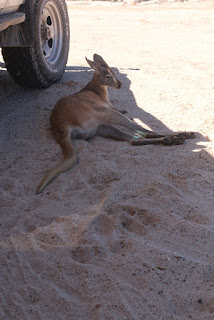 |
| Camel Riders on Cable Beach Broome |
As we have travelled north so the temperatures have increased, until here near Darwin they are an uncomfortable 40 degrees during the day, and generally not dropping below around 28 degrees at night. Hence we tend to visit places morning and evening and travel during the middle of the day when the car's air-conditioning provides relief from the heat.
 |
| Deserted outback road |
From Karijini National park we headed to Broome on the coast for a couple of day's relaxation and enjoyed lovely coastal scenery and visited the 100 year old outdoor cinema where the latest Hollywood blockbusters can be enjoyed under the stars.
 |
| Beautiful peaceful Windjana Gorge |
 |
| Freshwater Crocodile |
Having stocked up on food we headed north to the Kimberley which has some spectacular rugged sandstone scenery, with red vertical cliffs rising out of the plains and cascading waterfalls into deep cool plunge pools, many offering a chance to cool off.
The sandstone heights are frequently cut by deep narrow gorges which remain shaded and cool during the day. NW Australia is the home of the Boab tree - very similar to the Baobab of Africa with huge bloated trunks supporting a few short branches. The trees are just coming into leaf heralding the start of the wet season. Our first stop from Broome was Windjana Gorge where we enjoyed a spectacular thunderstorm overnight, followed by a glorious clear day when we walked through this peaceful gorge in an ancient Devonian barrier reef. The river through the gorge is inhabited by dozens of small (up to 3m long) freshwater crocodiles (freshies), which are claimed to be relatively harmless, unlike their bigger cousins the saltwater crocs (salties) which grow to 7m and can be very aggressive. Further along the same road is Tunnel creek - a natural river tunnel which winds 750m through the barrier reef which can be walked and waded through provided you have a good torch.
 |
| Wolfe Creek Meteorite Crater |
A detour took us to Wolfe Creek crater - the second largest meteorite crater in the world which is almost perfectly circular and rises out of a completely flat plain. It must have been a huge impact.
Purnulu National Park is home to the Bungle Bungles, which provide some strange rock formations with banded black and red sandstone domes rising from the plain. The sandstone is fissured providing a number of canyons ranging from the intimate Echidna Canyon which in places is only 1m wide, to Cathedral canyon which opens to a wide amphitheatre with a dramatic overhang under a wet season waterfall.
 |
| The Bungle Bungles |
 |
| Echidna Gorge |
 |
| Cathedral Gorge |
 |
| Pentecost River Crossing - Gibb River Road |
North again is El Questro Park with a series of stunning swimming holes set in deep sandstone canyons and encompassing several large rivers including Pentecost River which the Gibb River road crosses in a 200m long ford. From Western Australia we have crossed into Northern territories and headed north to Darwin, a reasonably large city in the "Top End" which has an amazing number of WW2 airfields and defences, as well as being adjacent to the Litchfield and Kakadu National Parks.
 |
| Aboriginal Rock Art in Kakadu |
Litchfield has some lovely walking trails through lush tropical valleys, while UNESCO listed Kakadu spans a wide range of habitats from coast, through swamp and floodplain to sandstone cliffs. Two excellent sites containing a lot of ancient Aboriginal rock art are set in the Park providing a glimpse of ancient Aboriginal culture, and the rock shelters they used for millennia.
One feaure of the NW is the number of birds of prey and the prolific and spectacular bird life in general, from the beautiful to the ugly.
 |
| The beautiful Comb Crested Jacana |
 |
| Masked Lapwing |
Having caught our breath in Darwin we are planning to head south through the centre to Alice Springs and Uluru.
 |
| Too hot for Kites |
 |
| A friendly spider trying to eat a beetle |
 |
| Driving hazard - 60m long road trains |

































